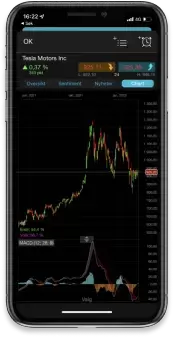Yesterday saw the Nasdaq 100 post its worst one day fall since March 2020, of 3.7%, driven by a 26% decline in Facebook owner Meta, which spilled over into a sympathy sell-off across the rest of the sector, but specifically in the likes of Snap, Pinterest, and Amazon.
The reason for the big falls in these three companies was over-concern about similar weakness ahead of their own earnings numbers, which came after the close. In a move that was whiplash inducing, all three posted numbers that were much better than expected, prompting a sharp reversal of these losses. Snap shares closed yesterday’s session 23.5% lower only to rally over 40% after hours, while Amazon rose 15% after hours after finishing the day 7.5% lower. These are eye-watering, stomach churning moves normally associated with penny stocks, and yet they are happening in companies with billion-dollar market caps, such is the fragile nature of sentiment.
European markets also underwent a significant decline yesterday, largely due to weakness in the tech sector, as well as some anxiety over rising inflation and tighter monetary policy, after the Bank of England raised interest rates by 0.25% and had four members push for a bigger 50bps move. This was rather unexpected, given only last week markets were concerned that the US Federal Reserve wanted to go big on a 50bps move, and now we have the Bank of England within one vote of doing exactly that. The ECB also adopted a change of emphasis on its outlook for inflation, with some sources inside the central bank suggesting March might bring about a “recalibration” of monetary policy.
As we look ahead to today’s price action, European markets look set to open higher in the wake of last night’s after-hours surge in US markets, as attention now shifts to this afternoon’s US non-farm payrolls report for January. Expectations are low for the headline number having seen weak reports for November and December, with numbers of 249,000, and 199,000 respectively, although unemployment fell back to 3.9%, and looks set to stay at that level, when the latest numbers drop today.
We’ve already been set up for a weak number for January by Philadelphia Fed President Patrick Harker earlier this week, when he said that because of the Omicron surge, and the sharp rise in weekly jobless claims at the beginning of January that the Fed was likely to look past a disappointing report. Nonetheless this week’s ADP report gave us a foretaste of what to expect today when a forecast of 180,000 turned into a decline of -301,000, with the decline put down to sickness, or absences due to people isolating through exposure to an infected person.
Over the past two weeks we’ve seen estimates for the payrolls number gradually come down from 238,000 to today’s estimate of 142,000, however if recent trends are any guide, we could just as easily see a print of -250,000, or even worse. Of course, the trick will be trying to parse the market reaction to a poor headline number; after all, how bad is a bad number, when there are over 10m vacancies that are unfilled?
For now, the Fed is more concerned about inflation, and if all other areas of the report look good then markets will probably focus on the unemployment rate, the participation rate which is expected to come in at 61.9%, and the wages data. This is where the Fed’s main concern is likely to be, apart from headline CPI next week, which could well rise further above 7%. In December average hourly earnings rose to 4.7%, from 4.2%, and in today’s numbers, forecasts are for another 0.5% gain to 5.2%.
We also have the Canada jobs report, with a similarly decent update potentially signalling a rate hike from the Bank of Canada at its next meeting.
EUR/USD – broke to the upside through the 1.1380 level and looks set for a retest of the recent highs at 1.1485, and potentially higher. We need to hold above the 1.1380 area for this to unfold with firmer support at the 1.1270 area.
GBP/USD – continues to edge higher, but still hasn’t quite reached the next resistance around the 1.3670 area. Support comes in at the 1.3520 area, which could be the launching point for a move towards the 200-day MA at 1.3720.
EUR/GBP – slipped back to the 0.8280 area yesterday, before embarking on a strong rebound back towards the recent highs at 0.8420. and looks set for a move back towards the 0.8500 area.
USD/JPY – found support just above the 114.00 area and has rallied back towards the 115.00 area. A break above 115.00 targets a return to the 115.70 level.
Disclaimer: CMC Markets is an execution-only service provider. The material (whether or not it states any opinions) is for general information purposes only, and does not take into account your personal circumstances or objectives. Nothing in this material is (or should be considered to be) financial, investment or other advice on which reliance should be placed. No opinion given in the material constitutes a recommendation by CMC Markets or the author that any particular investment, security, transaction or investment strategy is suitable for any specific person. The material has not been prepared in accordance with legal requirements designed to promote the independence of investment research. Although we are not specifically prevented from dealing before providing this material, we do not seek to take advantage of the material prior to its dissemination.







